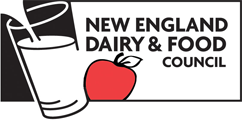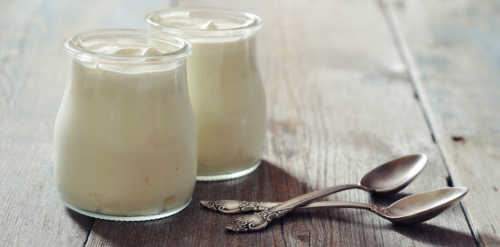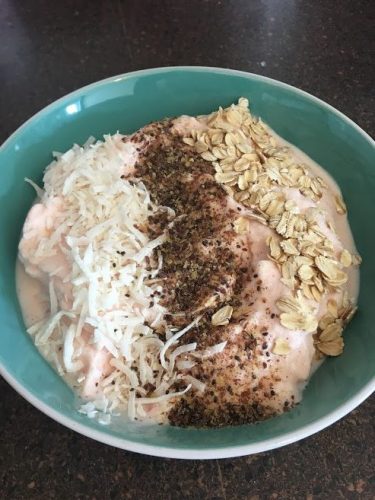Blog post written by University of New Hampshire dietetic intern Hailey Kuhl.
–
You may recall a previous post in which we debunked the idea of eating ice cream for breakfast. We gave some compelling reasons why it’s not the best choice, but what if I told you the ice cream for breakfast dream might not be lost, and that there still may be a chance after all?
Yes, we found a frozen yogurt idea that can get you as close to ice cream as you can, while keeping nutrition, protein, and sugar in check. Read on for the recipe and some considerations for making yogurt the base of your breakfast in this “sundae”.
More on yogurt
Yogurt is made by adding live active cultures (bacteria) to milk. The active cultures use the naturally occurring sugars in milk (lactose) to create lactic acid, which is what gives yogurt its hallmark tangy flavor. This process, called fermentation, may result in the presence of probiotics in some yogurts, which support gut health. There are several other benefits associated with yogurt:
- Yogurt has less lactose than milk. People who have a lactose intolerance (LI) may be able to digest yogurt better than they would milk or other dairy products with higher amounts of lactose. Learn more about LI and dairy foods that contain low levels of lactose in our blog post.
- Yogurt retains most of the nutrients that are present in milk, such as protein, calcium, B12, and others, making it a nutritious option. This infographic shows some of the nutrients that can be found in a 6-oz serving of low-fat vanilla yogurt.
The nutritional profile of different types of yogurt can vary. For example, Greek yogurt may contain more protein, even less lactose, and less calcium. Here’s more on Greek yogurt. For a deeper dive on different styles of yogurt and their nutritional profiles, check out this blog post.
Not all yogurts are created equal! Checking the nutrition facts label will provide you with more information on a particular style or brand of yogurt. Flavored or sweetened yogurts may contain enough added sugar to rival ice cream. To keep added sugars in yogurt to a minimum, stick to plain versions and sweeten naturally with fruit (which contain fiber and antioxidants) or maple syrup or honey (still considered sweeteners, but you can control the amount added).
Make your own fro-yo!
To make the following breakfast sundae recipe, start with plain yogurt as your base, and then add your own toppings. Recipe modified from Just a Taste.
Yields: 4 Servings
Ingredients:
- 1 cup plain low-fat or fat-free yogurt
- 1 cup low-fat or fat-free milk
- 2 cups frozen fruit of your choice (banana, mango, berries work well)
- 1 cup ice
- Toppings of your choice (nuts, seeds, grains, etc.)
Directions
- Add yogurt, milk, frozen fruit, and ice to blender
- Blend until thick and smooth (may need to stir with a spoon because mixture will be thick)
- Use an ice cream scoop to scoop into a bowl
- To serve- assemble as you would a sundae with breakfast-style toppings
Topping ideas– Toppings can make or break your breakfast sundae. The following will help you to feel full and energized through the morning:
- Nuts and seeds like peanut butter, sunflower, chia, almonds, walnuts, and pecans add fiber, protein, and healthy fats.
- Grains like toasted oat and whole grain cereals, or whole grain waffles, add fiber, vitamins, minerals
- Love fruit? Top with additional berries, banana, mango, pineapple, or other fruit for a pop of color.
Helpful Tips
- Use a powerful food processor/blender/immersion blender for a creamy texture
- Serve the product right away or store in an airtight container for up to one month in the freezer.
Nutrition Information
~1 cup portion made with fat-free yogurt and milk without toppings has 90 calories, 0g fat, 6g protein, 13g sugar. Making the recipe with low-fat yogurt and milk will bump up the calories and fat slightly.



